Critical Comparison: Public Stereotypes vs. Nurses' Characteristics
VerifiedAdded on 2022/10/31
|9
|2385
|343
Essay
AI Summary
This essay critically examines the divergence between the public's stereotypical views of nurses and the perspectives held by nurses themselves regarding the essential characteristics of their profession. It delves into how the media and cultural influences shape public perception, often leading to inaccurate and limiting portrayals. The essay analyzes the impact of these stereotypes on the nursing profession, including recruitment, retention, and professional satisfaction. Drawing on research, it contrasts public misconceptions with the realities of nursing, emphasizing the skills, knowledge, and autonomy nurses possess. Furthermore, the essay explores the evolving role of nurses in healthcare, highlighting their increasing responsibilities and contributions to patient care. Ultimately, the essay argues for a more accurate and positive representation of nurses to attract and retain individuals in the profession, emphasizing the need for societal recognition and support for their vital role in healthcare.
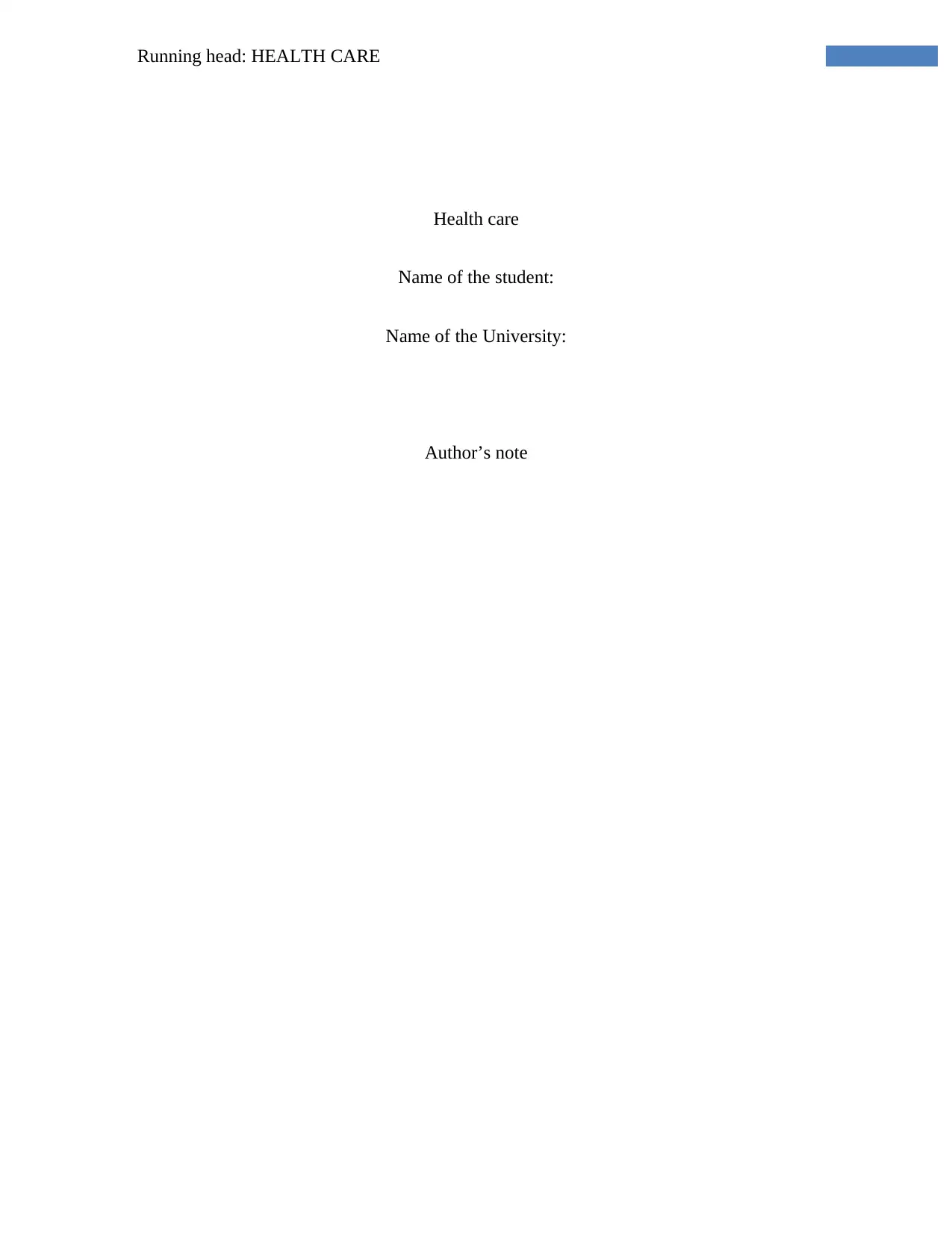
Running head: HEALTH CARE
Health care
Name of the student:
Name of the University:
Author’s note
Health care
Name of the student:
Name of the University:
Author’s note
Secure Best Marks with AI Grader
Need help grading? Try our AI Grader for instant feedback on your assignments.
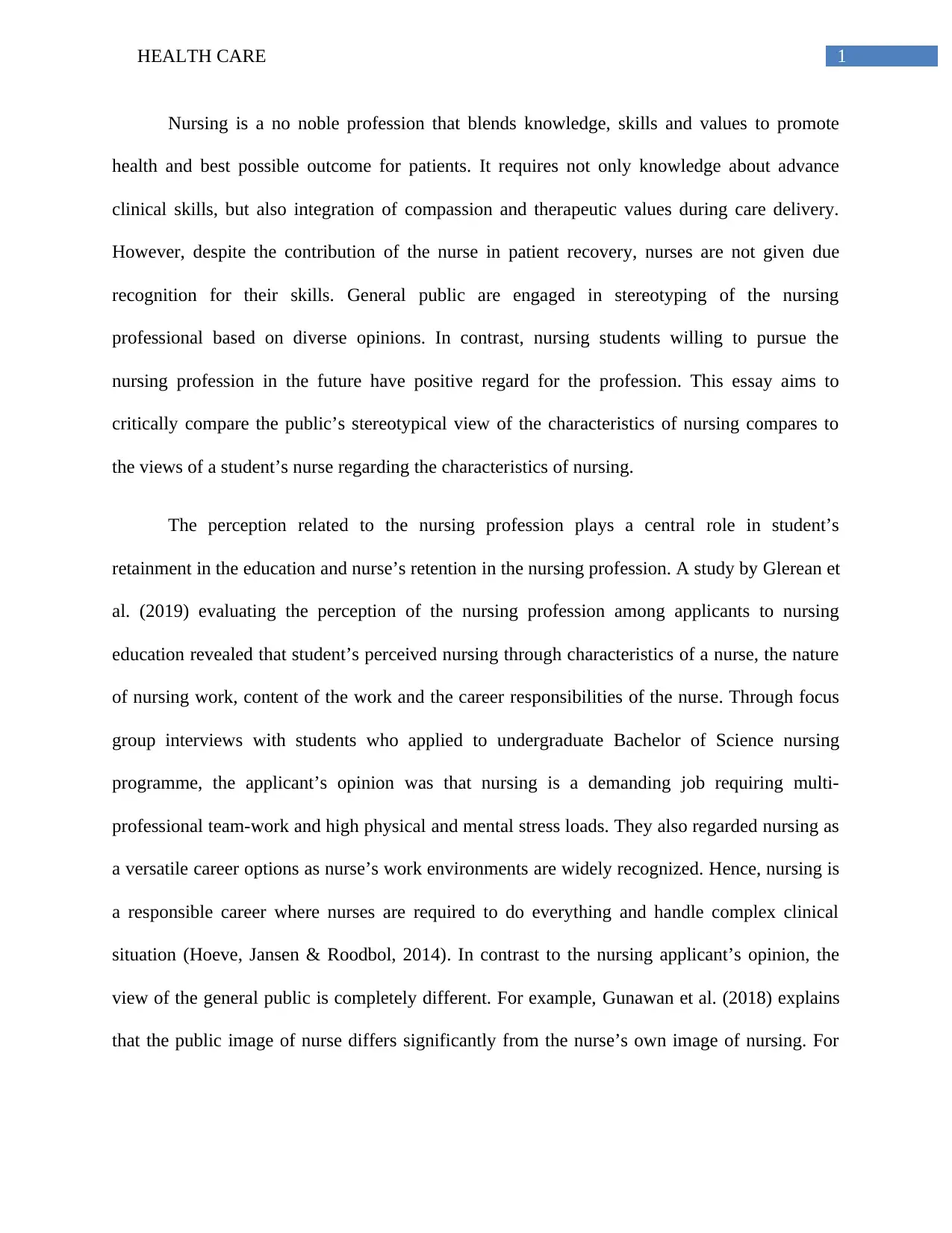
1HEALTH CARE
Nursing is a no noble profession that blends knowledge, skills and values to promote
health and best possible outcome for patients. It requires not only knowledge about advance
clinical skills, but also integration of compassion and therapeutic values during care delivery.
However, despite the contribution of the nurse in patient recovery, nurses are not given due
recognition for their skills. General public are engaged in stereotyping of the nursing
professional based on diverse opinions. In contrast, nursing students willing to pursue the
nursing profession in the future have positive regard for the profession. This essay aims to
critically compare the public’s stereotypical view of the characteristics of nursing compares to
the views of a student’s nurse regarding the characteristics of nursing.
The perception related to the nursing profession plays a central role in student’s
retainment in the education and nurse’s retention in the nursing profession. A study by Glerean et
al. (2019) evaluating the perception of the nursing profession among applicants to nursing
education revealed that student’s perceived nursing through characteristics of a nurse, the nature
of nursing work, content of the work and the career responsibilities of the nurse. Through focus
group interviews with students who applied to undergraduate Bachelor of Science nursing
programme, the applicant’s opinion was that nursing is a demanding job requiring multi-
professional team-work and high physical and mental stress loads. They also regarded nursing as
a versatile career options as nurse’s work environments are widely recognized. Hence, nursing is
a responsible career where nurses are required to do everything and handle complex clinical
situation (Hoeve, Jansen & Roodbol, 2014). In contrast to the nursing applicant’s opinion, the
view of the general public is completely different. For example, Gunawan et al. (2018) explains
that the public image of nurse differs significantly from the nurse’s own image of nursing. For
Nursing is a no noble profession that blends knowledge, skills and values to promote
health and best possible outcome for patients. It requires not only knowledge about advance
clinical skills, but also integration of compassion and therapeutic values during care delivery.
However, despite the contribution of the nurse in patient recovery, nurses are not given due
recognition for their skills. General public are engaged in stereotyping of the nursing
professional based on diverse opinions. In contrast, nursing students willing to pursue the
nursing profession in the future have positive regard for the profession. This essay aims to
critically compare the public’s stereotypical view of the characteristics of nursing compares to
the views of a student’s nurse regarding the characteristics of nursing.
The perception related to the nursing profession plays a central role in student’s
retainment in the education and nurse’s retention in the nursing profession. A study by Glerean et
al. (2019) evaluating the perception of the nursing profession among applicants to nursing
education revealed that student’s perceived nursing through characteristics of a nurse, the nature
of nursing work, content of the work and the career responsibilities of the nurse. Through focus
group interviews with students who applied to undergraduate Bachelor of Science nursing
programme, the applicant’s opinion was that nursing is a demanding job requiring multi-
professional team-work and high physical and mental stress loads. They also regarded nursing as
a versatile career options as nurse’s work environments are widely recognized. Hence, nursing is
a responsible career where nurses are required to do everything and handle complex clinical
situation (Hoeve, Jansen & Roodbol, 2014). In contrast to the nursing applicant’s opinion, the
view of the general public is completely different. For example, Gunawan et al. (2018) explains
that the public image of nurse differs significantly from the nurse’s own image of nursing. For
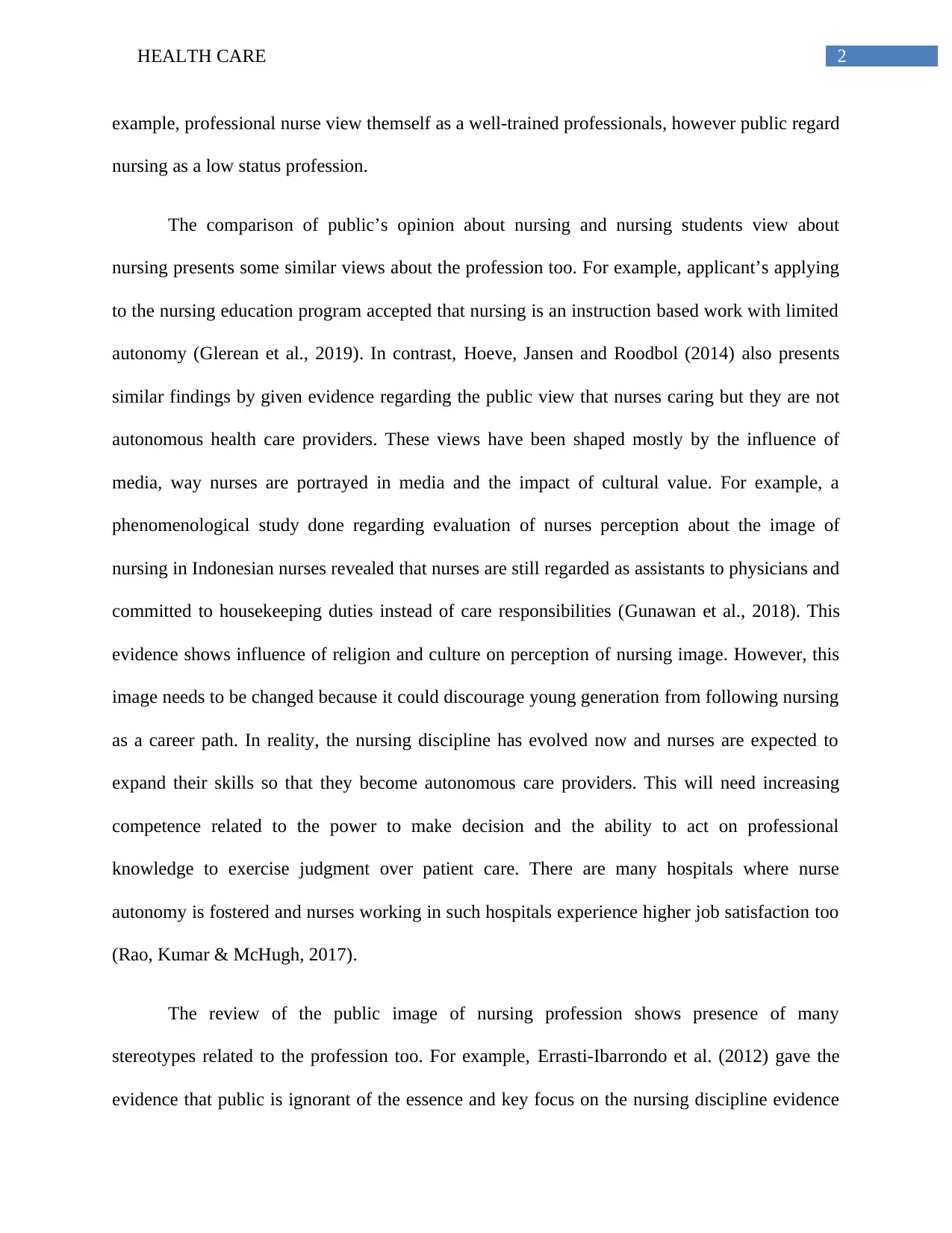
2HEALTH CARE
example, professional nurse view themself as a well-trained professionals, however public regard
nursing as a low status profession.
The comparison of public’s opinion about nursing and nursing students view about
nursing presents some similar views about the profession too. For example, applicant’s applying
to the nursing education program accepted that nursing is an instruction based work with limited
autonomy (Glerean et al., 2019). In contrast, Hoeve, Jansen and Roodbol (2014) also presents
similar findings by given evidence regarding the public view that nurses caring but they are not
autonomous health care providers. These views have been shaped mostly by the influence of
media, way nurses are portrayed in media and the impact of cultural value. For example, a
phenomenological study done regarding evaluation of nurses perception about the image of
nursing in Indonesian nurses revealed that nurses are still regarded as assistants to physicians and
committed to housekeeping duties instead of care responsibilities (Gunawan et al., 2018). This
evidence shows influence of religion and culture on perception of nursing image. However, this
image needs to be changed because it could discourage young generation from following nursing
as a career path. In reality, the nursing discipline has evolved now and nurses are expected to
expand their skills so that they become autonomous care providers. This will need increasing
competence related to the power to make decision and the ability to act on professional
knowledge to exercise judgment over patient care. There are many hospitals where nurse
autonomy is fostered and nurses working in such hospitals experience higher job satisfaction too
(Rao, Kumar & McHugh, 2017).
The review of the public image of nursing profession shows presence of many
stereotypes related to the profession too. For example, Errasti-Ibarrondo et al. (2012) gave the
evidence that public is ignorant of the essence and key focus on the nursing discipline evidence
example, professional nurse view themself as a well-trained professionals, however public regard
nursing as a low status profession.
The comparison of public’s opinion about nursing and nursing students view about
nursing presents some similar views about the profession too. For example, applicant’s applying
to the nursing education program accepted that nursing is an instruction based work with limited
autonomy (Glerean et al., 2019). In contrast, Hoeve, Jansen and Roodbol (2014) also presents
similar findings by given evidence regarding the public view that nurses caring but they are not
autonomous health care providers. These views have been shaped mostly by the influence of
media, way nurses are portrayed in media and the impact of cultural value. For example, a
phenomenological study done regarding evaluation of nurses perception about the image of
nursing in Indonesian nurses revealed that nurses are still regarded as assistants to physicians and
committed to housekeeping duties instead of care responsibilities (Gunawan et al., 2018). This
evidence shows influence of religion and culture on perception of nursing image. However, this
image needs to be changed because it could discourage young generation from following nursing
as a career path. In reality, the nursing discipline has evolved now and nurses are expected to
expand their skills so that they become autonomous care providers. This will need increasing
competence related to the power to make decision and the ability to act on professional
knowledge to exercise judgment over patient care. There are many hospitals where nurse
autonomy is fostered and nurses working in such hospitals experience higher job satisfaction too
(Rao, Kumar & McHugh, 2017).
The review of the public image of nursing profession shows presence of many
stereotypes related to the profession too. For example, Errasti-Ibarrondo et al. (2012) gave the
evidence that public is ignorant of the essence and key focus on the nursing discipline evidence
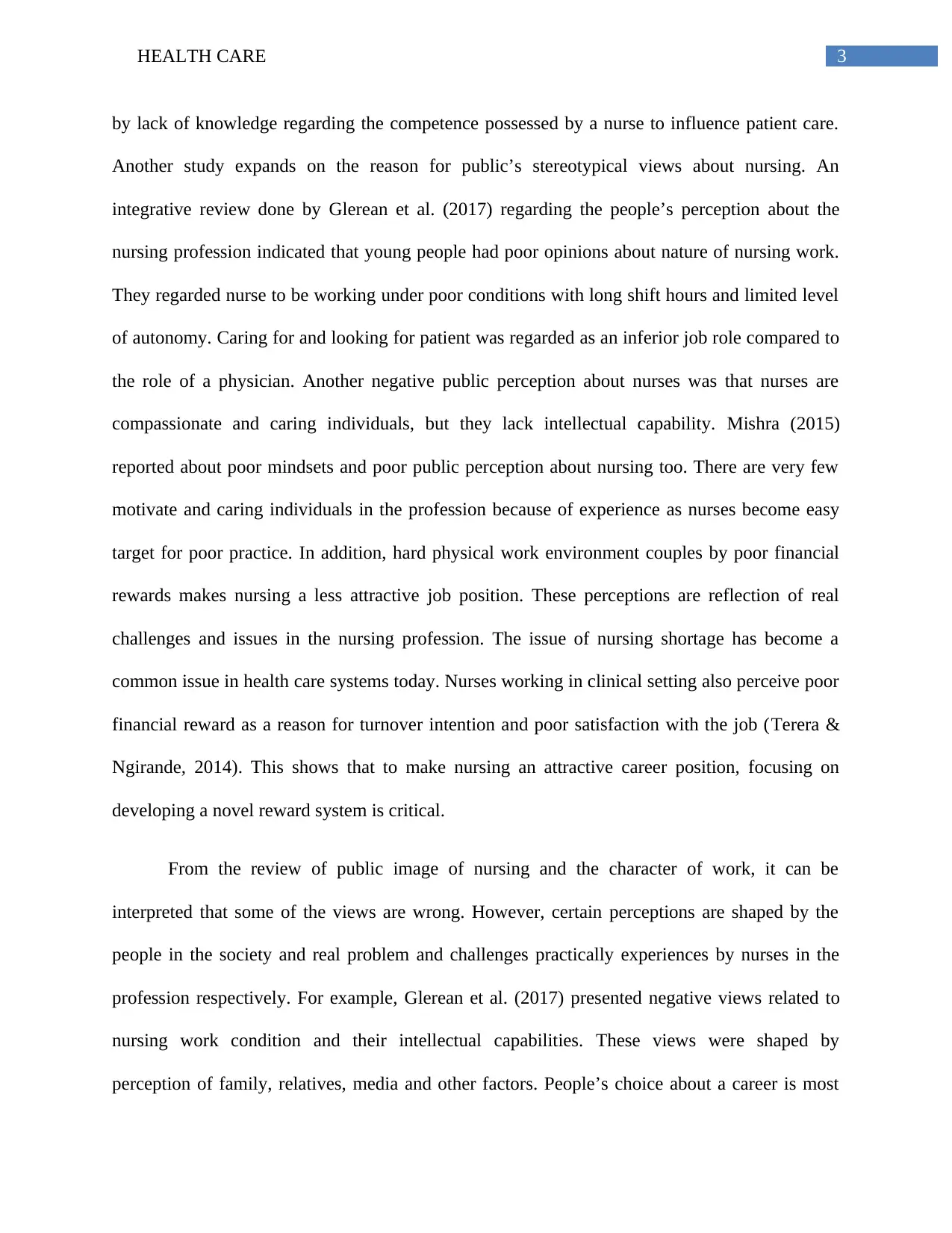
3HEALTH CARE
by lack of knowledge regarding the competence possessed by a nurse to influence patient care.
Another study expands on the reason for public’s stereotypical views about nursing. An
integrative review done by Glerean et al. (2017) regarding the people’s perception about the
nursing profession indicated that young people had poor opinions about nature of nursing work.
They regarded nurse to be working under poor conditions with long shift hours and limited level
of autonomy. Caring for and looking for patient was regarded as an inferior job role compared to
the role of a physician. Another negative public perception about nurses was that nurses are
compassionate and caring individuals, but they lack intellectual capability. Mishra (2015)
reported about poor mindsets and poor public perception about nursing too. There are very few
motivate and caring individuals in the profession because of experience as nurses become easy
target for poor practice. In addition, hard physical work environment couples by poor financial
rewards makes nursing a less attractive job position. These perceptions are reflection of real
challenges and issues in the nursing profession. The issue of nursing shortage has become a
common issue in health care systems today. Nurses working in clinical setting also perceive poor
financial reward as a reason for turnover intention and poor satisfaction with the job (Terera &
Ngirande, 2014). This shows that to make nursing an attractive career position, focusing on
developing a novel reward system is critical.
From the review of public image of nursing and the character of work, it can be
interpreted that some of the views are wrong. However, certain perceptions are shaped by the
people in the society and real problem and challenges practically experiences by nurses in the
profession respectively. For example, Glerean et al. (2017) presented negative views related to
nursing work condition and their intellectual capabilities. These views were shaped by
perception of family, relatives, media and other factors. People’s choice about a career is most
by lack of knowledge regarding the competence possessed by a nurse to influence patient care.
Another study expands on the reason for public’s stereotypical views about nursing. An
integrative review done by Glerean et al. (2017) regarding the people’s perception about the
nursing profession indicated that young people had poor opinions about nature of nursing work.
They regarded nurse to be working under poor conditions with long shift hours and limited level
of autonomy. Caring for and looking for patient was regarded as an inferior job role compared to
the role of a physician. Another negative public perception about nurses was that nurses are
compassionate and caring individuals, but they lack intellectual capability. Mishra (2015)
reported about poor mindsets and poor public perception about nursing too. There are very few
motivate and caring individuals in the profession because of experience as nurses become easy
target for poor practice. In addition, hard physical work environment couples by poor financial
rewards makes nursing a less attractive job position. These perceptions are reflection of real
challenges and issues in the nursing profession. The issue of nursing shortage has become a
common issue in health care systems today. Nurses working in clinical setting also perceive poor
financial reward as a reason for turnover intention and poor satisfaction with the job (Terera &
Ngirande, 2014). This shows that to make nursing an attractive career position, focusing on
developing a novel reward system is critical.
From the review of public image of nursing and the character of work, it can be
interpreted that some of the views are wrong. However, certain perceptions are shaped by the
people in the society and real problem and challenges practically experiences by nurses in the
profession respectively. For example, Glerean et al. (2017) presented negative views related to
nursing work condition and their intellectual capabilities. These views were shaped by
perception of family, relatives, media and other factors. People’s choice about a career is most
Secure Best Marks with AI Grader
Need help grading? Try our AI Grader for instant feedback on your assignments.
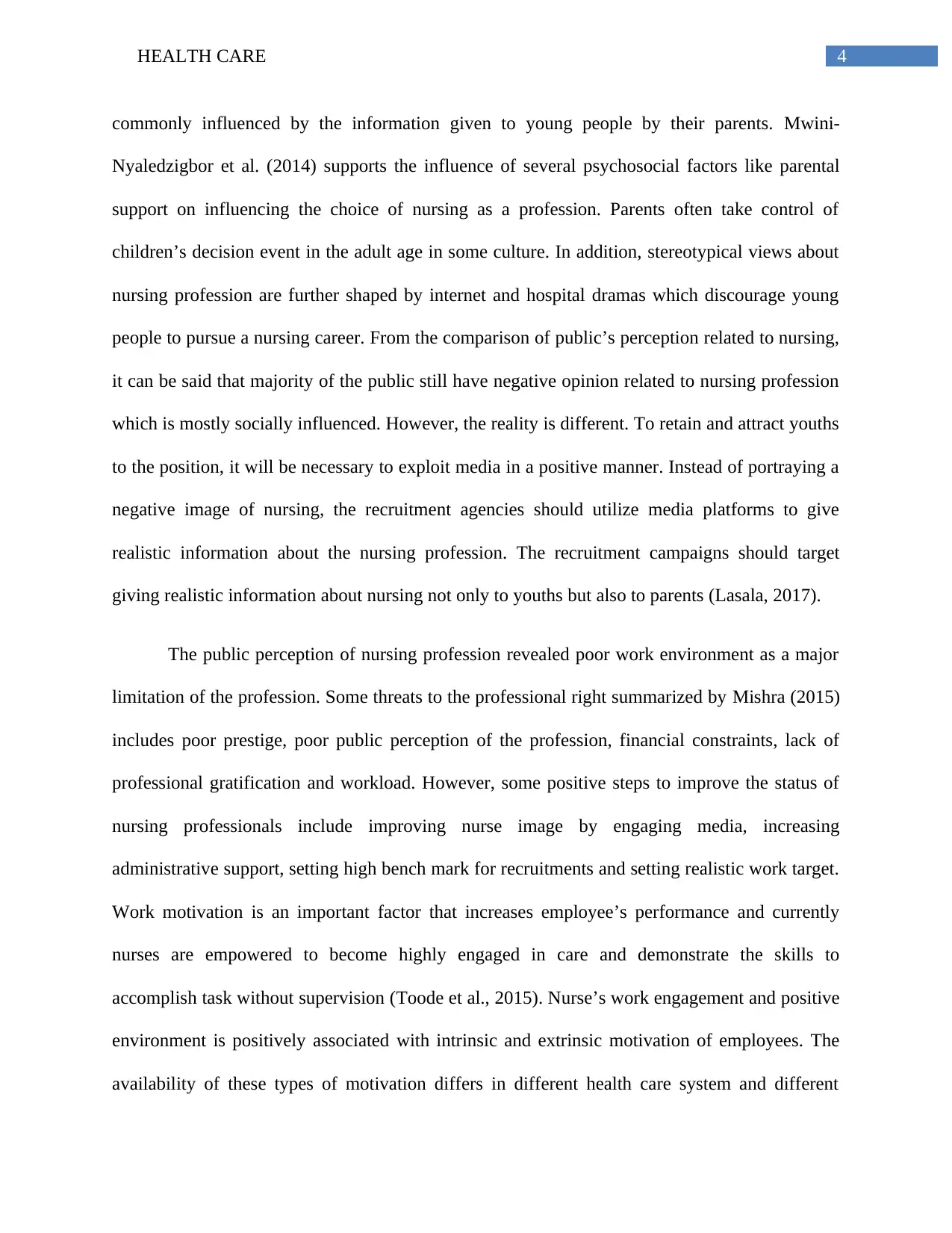
4HEALTH CARE
commonly influenced by the information given to young people by their parents. Mwini-
Nyaledzigbor et al. (2014) supports the influence of several psychosocial factors like parental
support on influencing the choice of nursing as a profession. Parents often take control of
children’s decision event in the adult age in some culture. In addition, stereotypical views about
nursing profession are further shaped by internet and hospital dramas which discourage young
people to pursue a nursing career. From the comparison of public’s perception related to nursing,
it can be said that majority of the public still have negative opinion related to nursing profession
which is mostly socially influenced. However, the reality is different. To retain and attract youths
to the position, it will be necessary to exploit media in a positive manner. Instead of portraying a
negative image of nursing, the recruitment agencies should utilize media platforms to give
realistic information about the nursing profession. The recruitment campaigns should target
giving realistic information about nursing not only to youths but also to parents (Lasala, 2017).
The public perception of nursing profession revealed poor work environment as a major
limitation of the profession. Some threats to the professional right summarized by Mishra (2015)
includes poor prestige, poor public perception of the profession, financial constraints, lack of
professional gratification and workload. However, some positive steps to improve the status of
nursing professionals include improving nurse image by engaging media, increasing
administrative support, setting high bench mark for recruitments and setting realistic work target.
Work motivation is an important factor that increases employee’s performance and currently
nurses are empowered to become highly engaged in care and demonstrate the skills to
accomplish task without supervision (Toode et al., 2015). Nurse’s work engagement and positive
environment is positively associated with intrinsic and extrinsic motivation of employees. The
availability of these types of motivation differs in different health care system and different
commonly influenced by the information given to young people by their parents. Mwini-
Nyaledzigbor et al. (2014) supports the influence of several psychosocial factors like parental
support on influencing the choice of nursing as a profession. Parents often take control of
children’s decision event in the adult age in some culture. In addition, stereotypical views about
nursing profession are further shaped by internet and hospital dramas which discourage young
people to pursue a nursing career. From the comparison of public’s perception related to nursing,
it can be said that majority of the public still have negative opinion related to nursing profession
which is mostly socially influenced. However, the reality is different. To retain and attract youths
to the position, it will be necessary to exploit media in a positive manner. Instead of portraying a
negative image of nursing, the recruitment agencies should utilize media platforms to give
realistic information about the nursing profession. The recruitment campaigns should target
giving realistic information about nursing not only to youths but also to parents (Lasala, 2017).
The public perception of nursing profession revealed poor work environment as a major
limitation of the profession. Some threats to the professional right summarized by Mishra (2015)
includes poor prestige, poor public perception of the profession, financial constraints, lack of
professional gratification and workload. However, some positive steps to improve the status of
nursing professionals include improving nurse image by engaging media, increasing
administrative support, setting high bench mark for recruitments and setting realistic work target.
Work motivation is an important factor that increases employee’s performance and currently
nurses are empowered to become highly engaged in care and demonstrate the skills to
accomplish task without supervision (Toode et al., 2015). Nurse’s work engagement and positive
environment is positively associated with intrinsic and extrinsic motivation of employees. The
availability of these types of motivation differs in different health care system and different
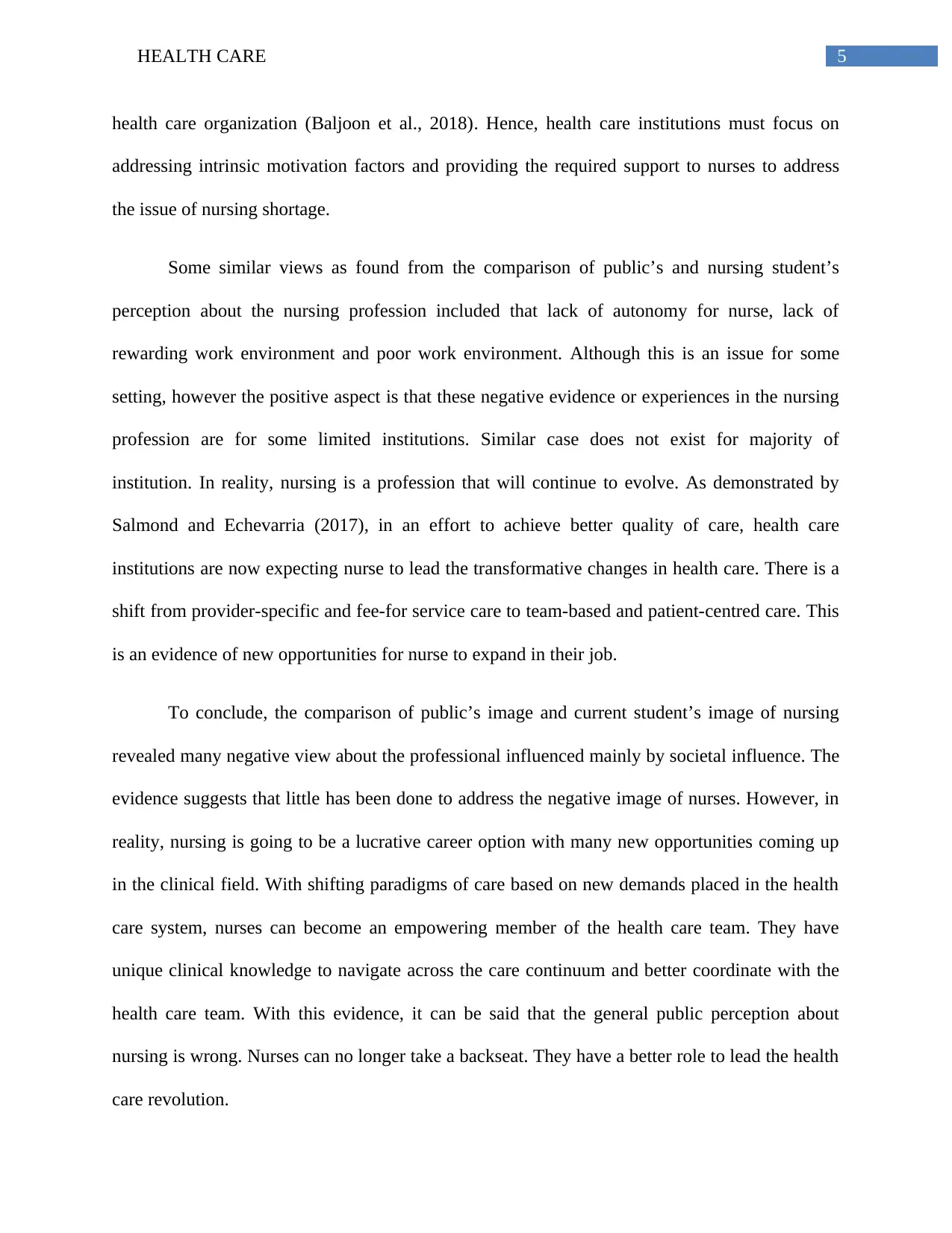
5HEALTH CARE
health care organization (Baljoon et al., 2018). Hence, health care institutions must focus on
addressing intrinsic motivation factors and providing the required support to nurses to address
the issue of nursing shortage.
Some similar views as found from the comparison of public’s and nursing student’s
perception about the nursing profession included that lack of autonomy for nurse, lack of
rewarding work environment and poor work environment. Although this is an issue for some
setting, however the positive aspect is that these negative evidence or experiences in the nursing
profession are for some limited institutions. Similar case does not exist for majority of
institution. In reality, nursing is a profession that will continue to evolve. As demonstrated by
Salmond and Echevarria (2017), in an effort to achieve better quality of care, health care
institutions are now expecting nurse to lead the transformative changes in health care. There is a
shift from provider-specific and fee-for service care to team-based and patient-centred care. This
is an evidence of new opportunities for nurse to expand in their job.
To conclude, the comparison of public’s image and current student’s image of nursing
revealed many negative view about the professional influenced mainly by societal influence. The
evidence suggests that little has been done to address the negative image of nurses. However, in
reality, nursing is going to be a lucrative career option with many new opportunities coming up
in the clinical field. With shifting paradigms of care based on new demands placed in the health
care system, nurses can become an empowering member of the health care team. They have
unique clinical knowledge to navigate across the care continuum and better coordinate with the
health care team. With this evidence, it can be said that the general public perception about
nursing is wrong. Nurses can no longer take a backseat. They have a better role to lead the health
care revolution.
health care organization (Baljoon et al., 2018). Hence, health care institutions must focus on
addressing intrinsic motivation factors and providing the required support to nurses to address
the issue of nursing shortage.
Some similar views as found from the comparison of public’s and nursing student’s
perception about the nursing profession included that lack of autonomy for nurse, lack of
rewarding work environment and poor work environment. Although this is an issue for some
setting, however the positive aspect is that these negative evidence or experiences in the nursing
profession are for some limited institutions. Similar case does not exist for majority of
institution. In reality, nursing is a profession that will continue to evolve. As demonstrated by
Salmond and Echevarria (2017), in an effort to achieve better quality of care, health care
institutions are now expecting nurse to lead the transformative changes in health care. There is a
shift from provider-specific and fee-for service care to team-based and patient-centred care. This
is an evidence of new opportunities for nurse to expand in their job.
To conclude, the comparison of public’s image and current student’s image of nursing
revealed many negative view about the professional influenced mainly by societal influence. The
evidence suggests that little has been done to address the negative image of nurses. However, in
reality, nursing is going to be a lucrative career option with many new opportunities coming up
in the clinical field. With shifting paradigms of care based on new demands placed in the health
care system, nurses can become an empowering member of the health care team. They have
unique clinical knowledge to navigate across the care continuum and better coordinate with the
health care team. With this evidence, it can be said that the general public perception about
nursing is wrong. Nurses can no longer take a backseat. They have a better role to lead the health
care revolution.
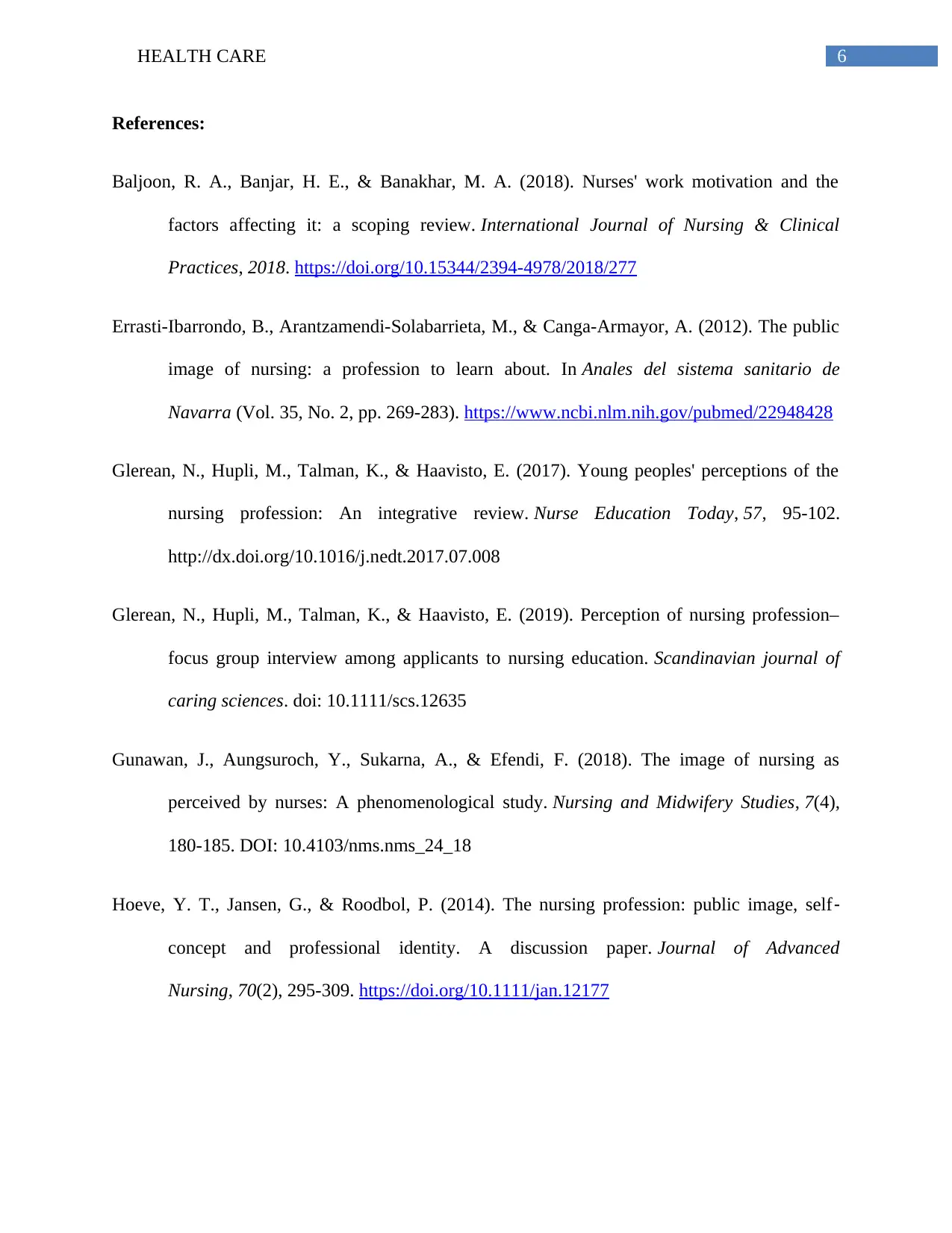
6HEALTH CARE
References:
Baljoon, R. A., Banjar, H. E., & Banakhar, M. A. (2018). Nurses' work motivation and the
factors affecting it: a scoping review. International Journal of Nursing & Clinical
Practices, 2018. https://doi.org/10.15344/2394-4978/2018/277
Errasti-Ibarrondo, B., Arantzamendi-Solabarrieta, M., & Canga-Armayor, A. (2012). The public
image of nursing: a profession to learn about. In Anales del sistema sanitario de
Navarra (Vol. 35, No. 2, pp. 269-283). https://www.ncbi.nlm.nih.gov/pubmed/22948428
Glerean, N., Hupli, M., Talman, K., & Haavisto, E. (2017). Young peoples' perceptions of the
nursing profession: An integrative review. Nurse Education Today, 57, 95-102.
http://dx.doi.org/10.1016/j.nedt.2017.07.008
Glerean, N., Hupli, M., Talman, K., & Haavisto, E. (2019). Perception of nursing profession–
focus group interview among applicants to nursing education. Scandinavian journal of
caring sciences. doi: 10.1111/scs.12635
Gunawan, J., Aungsuroch, Y., Sukarna, A., & Efendi, F. (2018). The image of nursing as
perceived by nurses: A phenomenological study. Nursing and Midwifery Studies, 7(4),
180-185. DOI: 10.4103/nms.nms_24_18
Hoeve, Y. T., Jansen, G., & Roodbol, P. (2014). The nursing profession: public image, self‐
concept and professional identity. A discussion paper. Journal of Advanced
Nursing, 70(2), 295-309. https://doi.org/10.1111/jan.12177
References:
Baljoon, R. A., Banjar, H. E., & Banakhar, M. A. (2018). Nurses' work motivation and the
factors affecting it: a scoping review. International Journal of Nursing & Clinical
Practices, 2018. https://doi.org/10.15344/2394-4978/2018/277
Errasti-Ibarrondo, B., Arantzamendi-Solabarrieta, M., & Canga-Armayor, A. (2012). The public
image of nursing: a profession to learn about. In Anales del sistema sanitario de
Navarra (Vol. 35, No. 2, pp. 269-283). https://www.ncbi.nlm.nih.gov/pubmed/22948428
Glerean, N., Hupli, M., Talman, K., & Haavisto, E. (2017). Young peoples' perceptions of the
nursing profession: An integrative review. Nurse Education Today, 57, 95-102.
http://dx.doi.org/10.1016/j.nedt.2017.07.008
Glerean, N., Hupli, M., Talman, K., & Haavisto, E. (2019). Perception of nursing profession–
focus group interview among applicants to nursing education. Scandinavian journal of
caring sciences. doi: 10.1111/scs.12635
Gunawan, J., Aungsuroch, Y., Sukarna, A., & Efendi, F. (2018). The image of nursing as
perceived by nurses: A phenomenological study. Nursing and Midwifery Studies, 7(4),
180-185. DOI: 10.4103/nms.nms_24_18
Hoeve, Y. T., Jansen, G., & Roodbol, P. (2014). The nursing profession: public image, self‐
concept and professional identity. A discussion paper. Journal of Advanced
Nursing, 70(2), 295-309. https://doi.org/10.1111/jan.12177
Paraphrase This Document
Need a fresh take? Get an instant paraphrase of this document with our AI Paraphraser
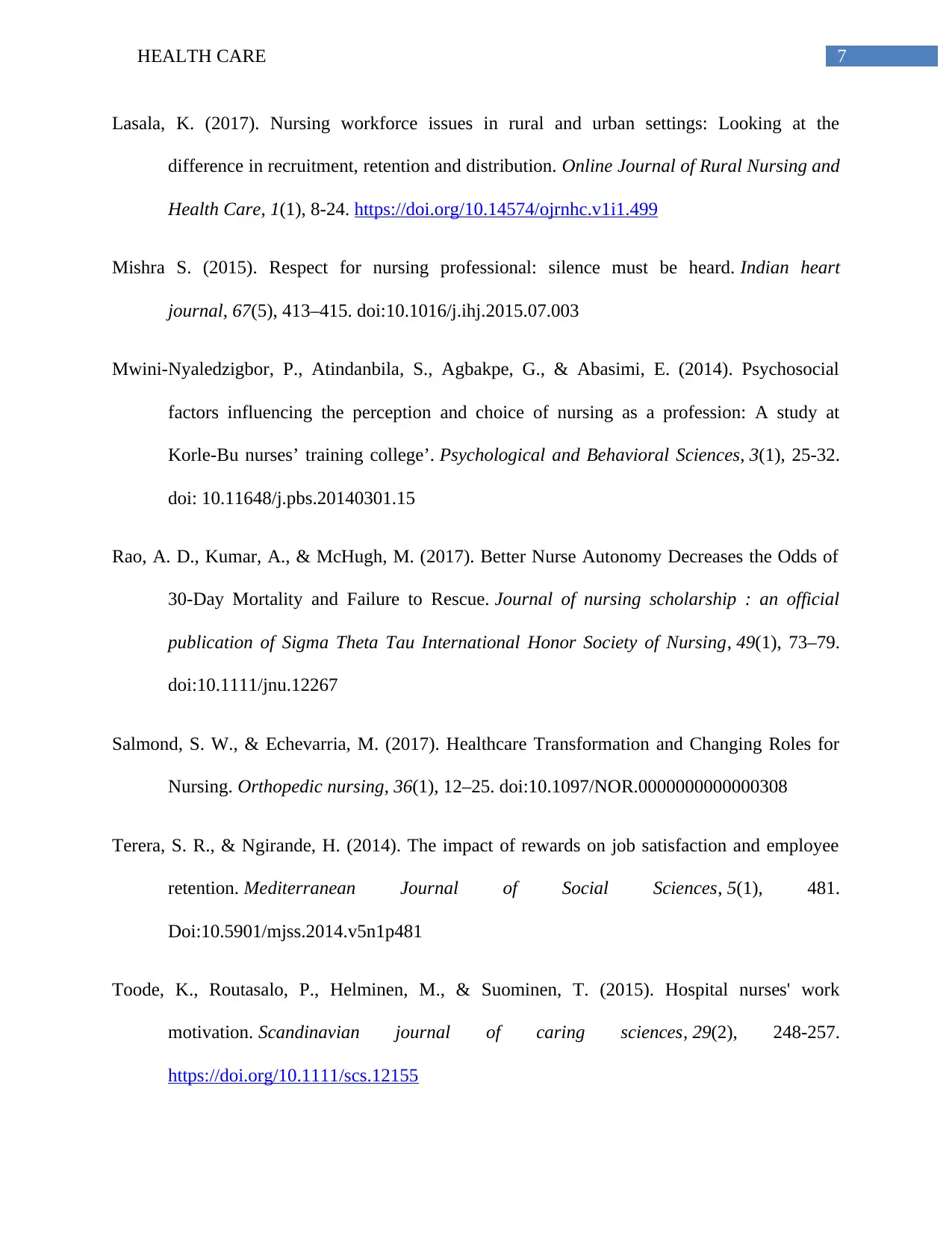
7HEALTH CARE
Lasala, K. (2017). Nursing workforce issues in rural and urban settings: Looking at the
difference in recruitment, retention and distribution. Online Journal of Rural Nursing and
Health Care, 1(1), 8-24. https://doi.org/10.14574/ojrnhc.v1i1.499
Mishra S. (2015). Respect for nursing professional: silence must be heard. Indian heart
journal, 67(5), 413–415. doi:10.1016/j.ihj.2015.07.003
Mwini-Nyaledzigbor, P., Atindanbila, S., Agbakpe, G., & Abasimi, E. (2014). Psychosocial
factors influencing the perception and choice of nursing as a profession: A study at
Korle-Bu nurses’ training college’. Psychological and Behavioral Sciences, 3(1), 25-32.
doi: 10.11648/j.pbs.20140301.15
Rao, A. D., Kumar, A., & McHugh, M. (2017). Better Nurse Autonomy Decreases the Odds of
30-Day Mortality and Failure to Rescue. Journal of nursing scholarship : an official
publication of Sigma Theta Tau International Honor Society of Nursing, 49(1), 73–79.
doi:10.1111/jnu.12267
Salmond, S. W., & Echevarria, M. (2017). Healthcare Transformation and Changing Roles for
Nursing. Orthopedic nursing, 36(1), 12–25. doi:10.1097/NOR.0000000000000308
Terera, S. R., & Ngirande, H. (2014). The impact of rewards on job satisfaction and employee
retention. Mediterranean Journal of Social Sciences, 5(1), 481.
Doi:10.5901/mjss.2014.v5n1p481
Toode, K., Routasalo, P., Helminen, M., & Suominen, T. (2015). Hospital nurses' work
motivation. Scandinavian journal of caring sciences, 29(2), 248-257.
https://doi.org/10.1111/scs.12155
Lasala, K. (2017). Nursing workforce issues in rural and urban settings: Looking at the
difference in recruitment, retention and distribution. Online Journal of Rural Nursing and
Health Care, 1(1), 8-24. https://doi.org/10.14574/ojrnhc.v1i1.499
Mishra S. (2015). Respect for nursing professional: silence must be heard. Indian heart
journal, 67(5), 413–415. doi:10.1016/j.ihj.2015.07.003
Mwini-Nyaledzigbor, P., Atindanbila, S., Agbakpe, G., & Abasimi, E. (2014). Psychosocial
factors influencing the perception and choice of nursing as a profession: A study at
Korle-Bu nurses’ training college’. Psychological and Behavioral Sciences, 3(1), 25-32.
doi: 10.11648/j.pbs.20140301.15
Rao, A. D., Kumar, A., & McHugh, M. (2017). Better Nurse Autonomy Decreases the Odds of
30-Day Mortality and Failure to Rescue. Journal of nursing scholarship : an official
publication of Sigma Theta Tau International Honor Society of Nursing, 49(1), 73–79.
doi:10.1111/jnu.12267
Salmond, S. W., & Echevarria, M. (2017). Healthcare Transformation and Changing Roles for
Nursing. Orthopedic nursing, 36(1), 12–25. doi:10.1097/NOR.0000000000000308
Terera, S. R., & Ngirande, H. (2014). The impact of rewards on job satisfaction and employee
retention. Mediterranean Journal of Social Sciences, 5(1), 481.
Doi:10.5901/mjss.2014.v5n1p481
Toode, K., Routasalo, P., Helminen, M., & Suominen, T. (2015). Hospital nurses' work
motivation. Scandinavian journal of caring sciences, 29(2), 248-257.
https://doi.org/10.1111/scs.12155
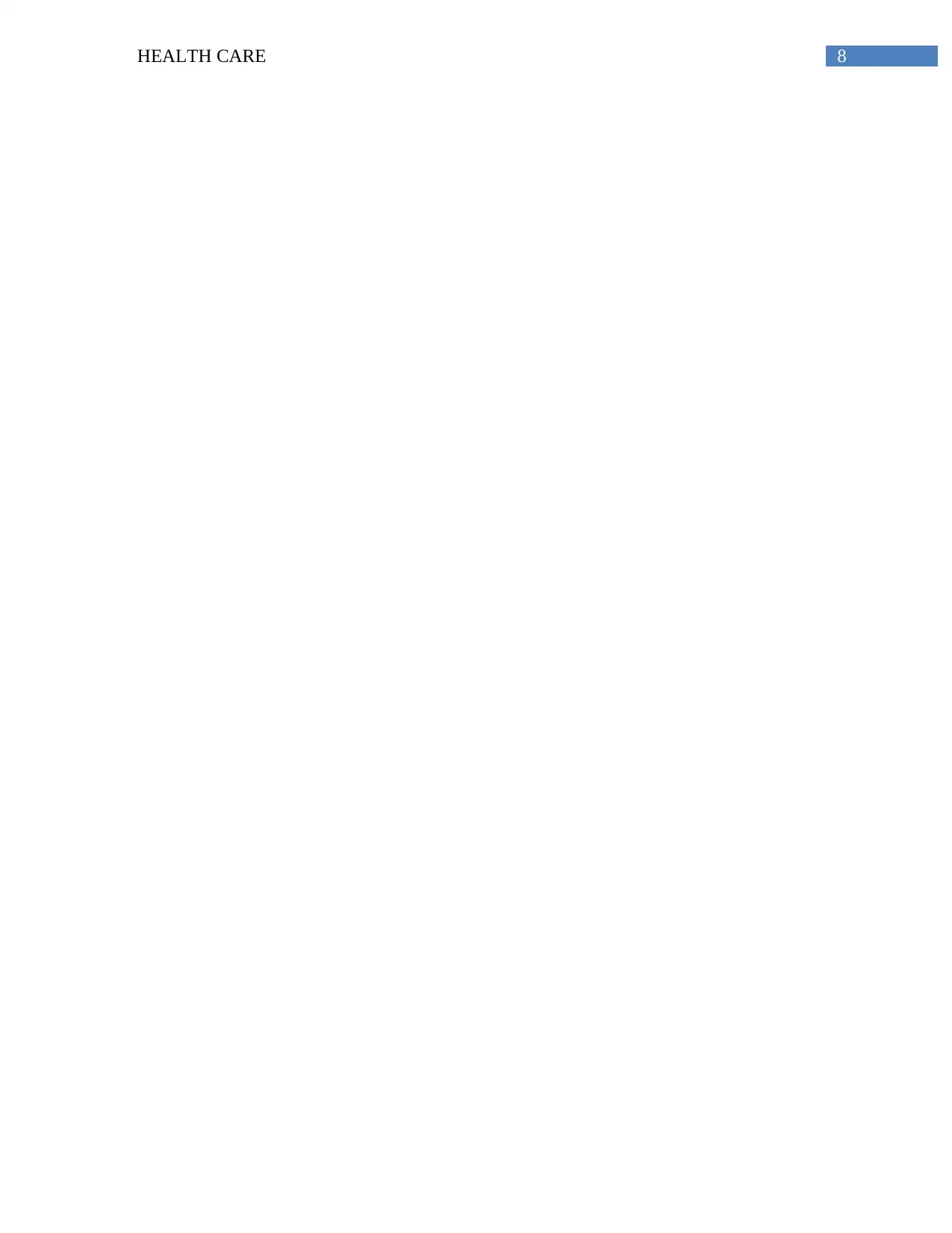
8HEALTH CARE
1 out of 9
Related Documents
Your All-in-One AI-Powered Toolkit for Academic Success.
+13062052269
info@desklib.com
Available 24*7 on WhatsApp / Email
![[object Object]](/_next/static/media/star-bottom.7253800d.svg)
Unlock your academic potential
© 2024 | Zucol Services PVT LTD | All rights reserved.




